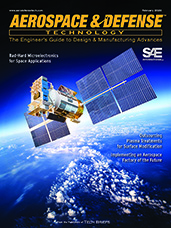Aerospace & Defense Technology
February 2020
- Rad-Hard Microelectronics for Space Applications
- Outsourcing Plasma Treatments for Surface Modification
- Adding Context to Full-Motion Video for Improved Surveillance and Situational Awareness
- Implementing an Aerospace Factory of the Future
- 90° Hybrid Coupled Power Amplifier - Pros and Cons
- A New Network Design for the "Internet from Space"
- Future Advances in Electronic Materials and Processes - Flexible Hybrid Electronics
Despite progress being made, there are still significant obstacles to the manufacture and use of flexi-ble hybrid electronics in military applications. - Heterogeneous Integration Technology
Integrating different types of devices and materials could increase their functional density, improving the performance of electro-optic systems for sensor applications. - The Impact of Cyber Cameras on the Intelligence Community
The ability to covertly access and manipulate cyber cameras could provide valuable strategic data for the US intelligence community. - Calculating Electrical Requirements for Direct Current Electric Actuators
When designing electro-mechanically actuated systems, there are several electrical design requirements that must be determined. - Weyl Semimetals (WSM) for Electronics Applications
New synthesized materials open the way to govern the density of helicity, axial charge, and its flow, axial current. - Energy Harvesting for Soft-Matter Machines and Electronics
A new class of soft multifunctional materials could be used to convert mechanical deformation from vibrations and stretching into electrical energy. - Evaluation of the Effects of Hydrogen Peroxide on Common Aircraft Electrical Materials
Study aims to find a suitable decontaminant/disinfectant/sanitizer that can be used successfully in complex transportation vehicles with no negative impact on sensitive electronic equipment.
Related Topics:

